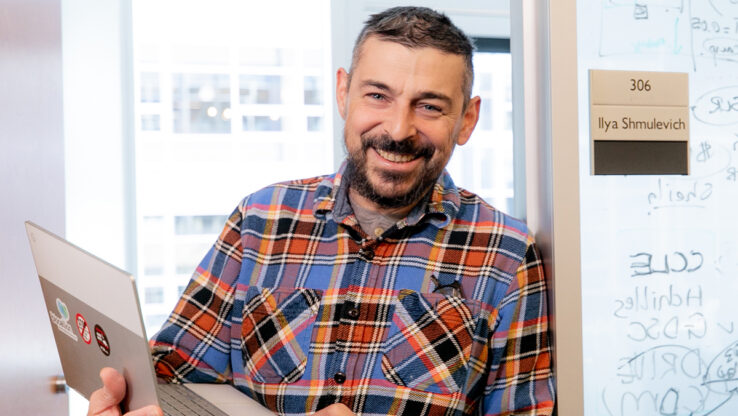Jim Heath:
Hi, my name is Jim Heath. I’m the president of the Institute of Systems Biology, and I’m here with my student who’s actually now a Marshall Fellow at Cambridge University, Daniel Chen. And we’re here today to talk about a paper that we’ve just published in Cell Reports. And the title of the paper is a bit of a mouthful. Daniel, what’s the title again?
Daniel Chen:
Integrative Systems Biology Reveals NKG2A-Biased Immune Responses Correlate With Protection In Infectious Disease, Autoimmune Disease, and Cancer.
Jim Heath:
So in this study, what Daniel did is basically looked for immunological signatures that were common across a broad variety of human diseases – two viral diseases, an autoimmune condition, and basically pan-cancer, meaning almost all cancers. The motivation for this study has to do with trade-offs that patients oftentimes receive when they are treated for one disease and may become susceptible for another. So it’s not always appreciated, but for example, cancer patients most often die of infection and certain cancer treatments can also increase a person’s risk of getting autoimmune conditions. That’s well-known. And in fact, there are also autoimmune treatments that can increase the patient’s risk of infectious disease and even cancer. When you think about all these different disease conditions, which are all pretty bad diseases, and you think about trading one disease for another, how did you think about avoiding that in the type of study you did, Daniel?
Daniel Chen:
Right. I think what we needed to do was zoom in onto the actual cell-by-cell level, and we can do that with single-cell technologies. And we’re only able to do that now because there are so many single-cell technology datasets now available for these major classes of disease. So once we zoom in onto the cell-by-cell level, it’s a pretty fundamental problem across all three diseases. There’s some type of chronic or pathogenic inflammation that is either killing off the immune cells and cancer or preventing their true function and good function in infection and autoimmune disease.
Jim Heath:
Right. And in fact, in the study, you looked at two infectious diseases, they’re viral infections, Chikungunya and COVID-19, but even in that context, you’re able to look at a couple of different studies. You looked at systemic lupus erythematosus, oftentimes just called lupus, which is an autoimmune disease that affects a large number of people, and then virtually every cancer. And I think a really critical aspect of the study was that in each of those diseases or disease settings, we had a large number of patients, really, a couple hundred to several thousand in the case of cancer. And that kind of data just wasn’t available a couple years ago. And so in a nutshell, what were your major findings, Daniel?
Daniel Chen:
Yeah. So our major finding is CD8 T cells that bear this NKG2A receptor have the ability through that receptor signaling to kind of modulate their behavior. So in cancer, they’re really enriched for T resident memory cells. These are cells that can sit in the tumor and expand and kill off the tumor cells, but also bear some memory features that allow them to live for a long time and aren’t susceptible to immediate cell death through other mechanisms such as inflammation and antigen induced cell death. In infection and autoimmune disease, we know there’s a lot of pathogenic inflammation. So you can think during COVID, a lot of people are in the ICU because they’re really inflamed and there’s a lot of inflammatory cytokines. These T cells are ones that bear to a receptor that allow them to modulate the inflammation. And so they’re actually the ones who are able to fight off the virus without leading to this unnecessary inflammation and disease.
Jim Heath:
Right, because oftentimes I think this is something that happened during the pandemic, inflammation gets a little bit out of control. And in fact, you identified this, there’s a well-known pair of molecules, NKG2A and NKG2C, and they’re pretty interesting. There’s sort of a yin and yang of markers that you never see the same, both these markers on the same cell. The cells that are NKG2A positive have this, I guess, immune regulatory behavior or immune modulating behavior, whereas the NKG2C cells are really quite aggressive and pro-inflammatory. We had a very deep data set on the COVID, which allowed you to explore this very thoroughly, but the results you found in lupus were very striking in terms of the segregation of the lupus patients and the healthy patients. And what did you find there? Maybe describe a little bit.
Daniel Chen:
Right. So I think lupus is often thought of as a B-cell disease. And of course B cells are a large component, but a lot of incoming literature has shown that there’s a large T cell component to this. And so that’s exactly what you said. And we’ve found is for lupus patients, it’s basically like night and day where lupus patients have this huge expanded population of NKG2C positive CD8 T cells. They’re highly interferon gamma positive. They’re similar to proliferating cells. They’re basically this hub of cells that will proliferate, produce inflammation, and have effective behavior. And so maybe somewhat self-reactive, although we didn’t have the analysis to really touch on that.
Jim Heath:
And in cancer, looking at something like 20,000 patients across many cancers, the same story emerges. It’s not quite as crystal clear in terms of whether NKG2A positive patients or if that bias in the patient’s immune response is protective. It seems to be protective in some cases and never is NKG2C protective.
Daniel Chen:
Right.
Jim Heath:
Yeah. And it kind of makes sense in that it does associate with these T resident memory cells, which are thought to be important, I guess, anti-tumor immune cells. But also you found a little bit of evidence that these NKG2A cells, they’re not just spectators, right? They’re sitting right next to tumors.
Daniel Chen:
Right. So I think that’s one of the important things to clarify is we call NKG2A immunomodulating and memory-like, but that doesn’t mean they aren’t effector cells. Both 2A positive and NKG2C positive cells, they’re both effectors, they’re both in this cytotoxic activity. One just is able to live a bit longer and modulate activity, and the other is hyperinflammatory. So as you said, the NKG2A positive ones, we see them sit in tumor from spatial analyses. We see them associated with increased immune recruitment from bulk analyses. We see them bear resident memory features from single cell. There are a lot of signs that point to the fact that they’re in tumor and likely somehow involved in recruiting immune cells and clearing tumor and leading hopefully to patient survival and response.
Jim Heath:
I think it’s probably safe to say that this is… It’s not quite pan-disease because we only looked at one autoimmune disease, we only looked at two infections, but it’s pan-cancer and it’s certainly multi-disease. It’s probably the largest multi-disease study that’s been reported to date and really shows the value of looking across these disease settings for common immunological signatures. And I think a lot of people might want to know, what does it mean? Is this a marker? Are there drug targets that come out of this? I think you can say pretty clearly that NKG2A, which has been thought to be a drug target for a while in cancer, is not a good drug target. I mean, that was kind of a very clear observation, even though it’s actually been tried in clinical trials. But we can’t really say much in terms of detailed mechanism yet, can we?
Daniel Chen:
No, not yet. I think we have observed some hints. So we know that T resident memory cells are induced by TGF-beta and IL-12. We know that NKG2A is also induced by TGF-beta and IL-12. So there are some hints that I think our analyses reveal, and so these are some potential directions that require further exploration. But I think it’s helped to narrow down where should we explore, what should be the next steps to figure this out on a deeper level.
Jim Heath:
Yeah, and you did find that NKG2A biased patients for at least a couple of cancers was actually a pretty good indicator of the patient’s ability to survive the cancer for quite a long time. And that might be a good place to start. What were those cancers? Maybe elaborate on that a little bit.
Daniel Chen:
I think we see the strongest signal in kidney cancers. As you mentioned, it’s not every cancer where we see a huge positive signal, but there’s never a case where NKG2A correlates with worse survival. So a few cancers like kidney seem to do better. Why that occurs and why it’s so tissue specific might require deeper understandings of what are the cells also there, how could NKG2A be interacting with the native tissue? But it does appear like there is maybe a tissue bias and overall some type of benefit or help.
Jim Heath:
Well, congratulations. It’s yet another really beautiful paper that you’ve managed to lead and look forward to the next one. Thank you, Daniel.
Daniel Chen:
Same here. Thank you.
 isbscience.org/news/2024/03/04/common-immune-response-protective-across-many-diseases/
isbscience.org/news/2024/03/04/common-immune-response-protective-across-many-diseases/




